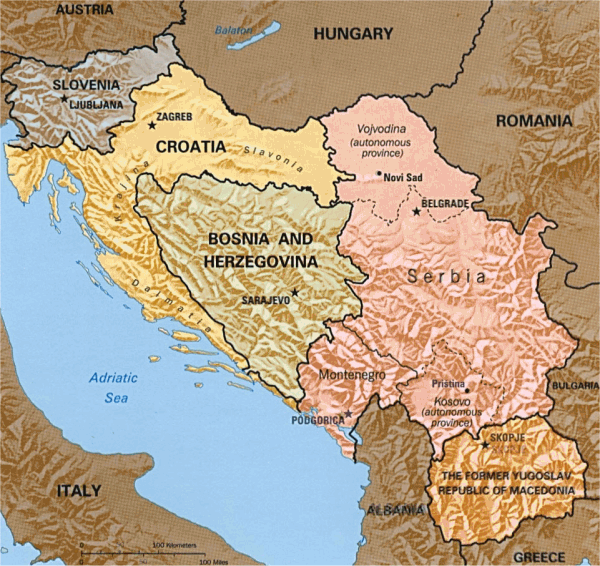Bosnia: Difference between revisions
mNo edit summary |
mNo edit summary |
||
| Line 5: | Line 5: | ||
[[Image:Bosnia-former-yugoslavia.png]] | [[Image:Bosnia-former-yugoslavia.png]] | ||
In April 1992 Bosnia and Herzegovina declared independence. Bosnia was the most ethnically diverse of all the Yugoslavian republics. According to the 1991 Yugoslavian census, Bosnia was 43% Muslim, 31% Serbian, and 17% Croatian. | In April 1992 Bosnia and Herzegovina declared independence. Bosnia was the most ethnically diverse of all the Yugoslavian republics. According to the 1991 Yugoslavian census, Bosnia was 43% Muslim, 31% Serbian, and 17% Croatian. War soon broke out among the different groups during the 1990s. | ||
The wars of Yugoslav secession involved complex and disputed claims for self determination and independence. In June 1991 Slovenia and Croatia declared independence, thus beginning the process of dissolution. Bosnia-Herzegovina’s declaration of sovereignty was followed by a referendum for independence in February 1992. Full-scale hostilities started in April, when Bosnian Serbs responded by trying to partition the Republic along ethnic lines, join Serbia, and form a “Greater Serbia.” | |||
Most Serbs wanted to keep Bosnia as part of the Yugoslav federation. The declaration of sovereignty was boycotted by the great majority of Bosnian Serbs even though the majority vote was for independence. | |||
From March 1992 to November 1995 the Bosnian war took place. The war involved neighboring countries Croatia and Serbia and Montenegro, making it difficult to determine if it was truly a civil war. | |||
In November 1995, the Dayton Peace Agreement (DPA) ended the three-and-a-half-year war. Bosnia-Herzegovina was maintained as an independent and unified state, with a multi-ethnic and democratic government with limited functions in foreign, economic, and fiscal policy. Internally the country was divided between two “Entities” with extended sovereign prerogatives: a Croat/Muslim Federation covering 51% of the territory and a Serb-led Republika Srpska (RS) covering the remaining 49%. | |||
[[Category:History]] | [[Category:History]] | ||
[[Category:Geography]] | [[Category:Geography]] | ||
Revision as of 09:20, 2 July 2007
Bosnia and Herzegovina make up a triangular-shaped republic, about half the size of Kentucky, on the Balkan peninsula. The Bosnian region in the north is mountainous and covered with thick forests. The Herzegovina region in the south is largely rugged, flat farmland. It has a narrow coastline without natural harbors stretching 13 mi (20 km) along the Adriatic Sea.
Bosnia was formerly part of Socialist Yugoslavia. From 1945 to 1991 Bosnia was not independent. The Federal People's Republic of Yugoslavia was composed of six republics: Serbia, Croatia, Bosnia and Herzegovina, Macedonia, Slovenia, and Montenegro, as well as two provinces, Kosovo and Vojvodina.
In April 1992 Bosnia and Herzegovina declared independence. Bosnia was the most ethnically diverse of all the Yugoslavian republics. According to the 1991 Yugoslavian census, Bosnia was 43% Muslim, 31% Serbian, and 17% Croatian. War soon broke out among the different groups during the 1990s.
The wars of Yugoslav secession involved complex and disputed claims for self determination and independence. In June 1991 Slovenia and Croatia declared independence, thus beginning the process of dissolution. Bosnia-Herzegovina’s declaration of sovereignty was followed by a referendum for independence in February 1992. Full-scale hostilities started in April, when Bosnian Serbs responded by trying to partition the Republic along ethnic lines, join Serbia, and form a “Greater Serbia.”
Most Serbs wanted to keep Bosnia as part of the Yugoslav federation. The declaration of sovereignty was boycotted by the great majority of Bosnian Serbs even though the majority vote was for independence.
From March 1992 to November 1995 the Bosnian war took place. The war involved neighboring countries Croatia and Serbia and Montenegro, making it difficult to determine if it was truly a civil war.
In November 1995, the Dayton Peace Agreement (DPA) ended the three-and-a-half-year war. Bosnia-Herzegovina was maintained as an independent and unified state, with a multi-ethnic and democratic government with limited functions in foreign, economic, and fiscal policy. Internally the country was divided between two “Entities” with extended sovereign prerogatives: a Croat/Muslim Federation covering 51% of the territory and a Serb-led Republika Srpska (RS) covering the remaining 49%.
